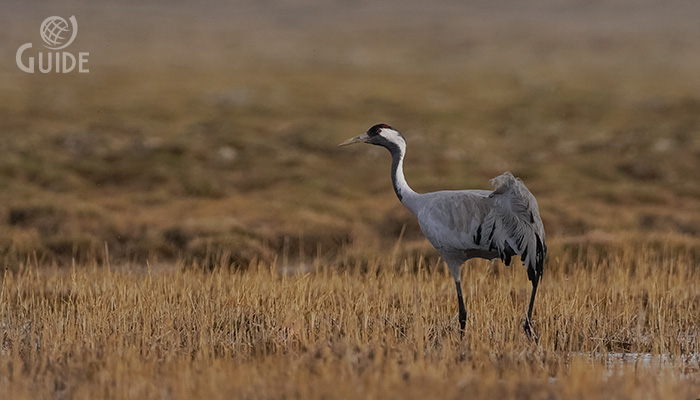
English: Common
Crane, Eurasian Crane
Russian: Серый журавль
German: Graukranich
(Kranich)
French: Grue cendree
Mongolian: Хархираа тогоруу
Japanese: クロヅル (Kuro-zuru)
Normal
0
false
false
false
EN-US
JA
X-NONE
Body length: 96-125 cm
Wing span: 180-200 cm
Passage migrant
Breeding season: May-August
Egg number:1-2
Egg colour: Pale-greenish
yellow with dark brown spots.
Brood: 1 per year
Food: Invertebrates, roots,
fruits, buds, green plants and leaves.
Status: Rare species. According to the IUCN Red List categories and criteria,
the species evaluated as-Near Threatened.
Distribution and Range: The species winters in northern Africa, Iran, South Asian
territories, India, and China. In Mongolia: Rivers and lakes in the Mongol
Altai, damp meadows, wetland meadows of the Dorgon, Khar-Us, Airag, Khyargas,
and Uvs Lakes in the Great Lake depression, Khangai, Khentii, valleys of large
rivers of the Eastern Mongolia, marshy lakes. During migration passage occurs
in the Great Lakes Depression, valleys of the Bulgan Khalkh, Selenge, Orkhon,
Tuul, and Ulz Rivers. Gathers in large groups before migration. During
migration rest and refuel in wheat fields.
Habitat: Breeding habitats are marshy lake shores, wetland meadows in remore
areas. Nests in reed beds in higher grounds in marshy areas.
Population and Threats: Population abundance and threats assessment has not been done.
There is record of 200-300 Cranes gathering in the Airkhan Lake Valley in 2012.
Conservation Measures: Listed as Rare animal In the Annex to the Mongolian Government
Resolution #7 (2012). Majority of the areas of large gatherings of the species
for summering, and resting areas during its migration passage is protected
within the NSPAN. Included in the Annex II, CITES and the Annex II, CMS.
Further Actions: Create a conservation management plan for habitat areas within
the NSPAN, covered in the Annexes, Appendixes of International Conventions,
assess the population abundance.